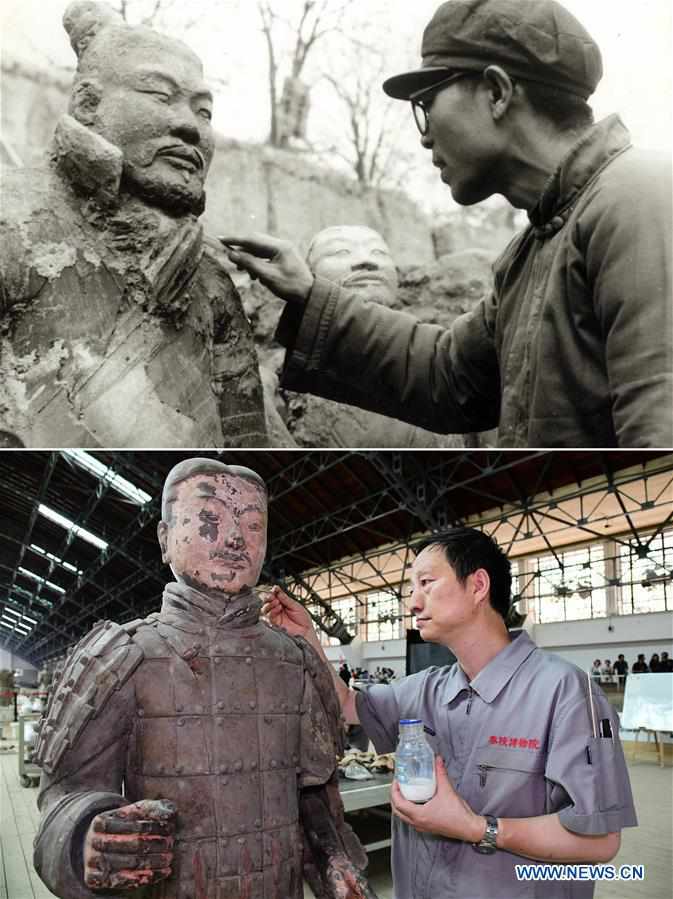


Top: File photo taken in 1974 and provided by Emperor Qinshihuang's Mausoleum Site Museum shows Yuan Zhongyi, the then-head of an archeological team, cleaning a terracotta warrior at the excavation site in Xi'an, capital of northwest China's Shaanxi Province. Bottom: Photo taken on July 4, 2019 by Li Yibo shows Lan Desheng, a cultural relic restorer at Emperor Qinshihuang's Mausoleum Site Museum, consolidating the color of a terracotta warrior after restoration in Xi'an. The Emperor Qinshihuang Mausoleum and Terracotta Warriors were included in the World Heritage list by UNESCO in 1987. To better repair and preserve the Terracotta Warriors, the Emperor Qinshihuang's Mausoleum Site Museum established special labs, including a microscopic analysis lab, a scanning electron microscope lab, a microbiology lab, a colored cultural relics preservation lab and a comprehensive restoration lab, as a way to equip cultural relic restorers with state-of-the-art technologies to protect the warriors. Many techniques to restore the warriors have obtained national patents. In 1949 when the People's Republic of China was founded, the Chinese people faced a devastated country that needed to be rebuilt from scratch after decades of warfare and chaos. After decades of unremitting endeavors and dedication by the Chinese people, China has grown to be the world's second largest economy. In 1952, China's GDP was 30 billion U.S. dollars, while in 2018, its GDP reached 13.61 trillion U.S. dollars, an increase of 452.6 times. A group of combo photos give you a glimpse of what Chinese people did decades ago and what they do right now. Undoubtedly, people from all walks of life in China with hard work and wisdom have made contributions to the country's development. (Xinhua)
 |

 Award-winning photos show poverty reduction achievements in NE China's Jilin province
Award-winning photos show poverty reduction achievements in NE China's Jilin province People dance to greet advent of New Year in Ameiqituo Town, Guizhou
People dance to greet advent of New Year in Ameiqituo Town, Guizhou Fire brigade in Shanghai holds group wedding
Fire brigade in Shanghai holds group wedding Tourists enjoy ice sculptures in Datan Town, north China
Tourists enjoy ice sculptures in Datan Town, north China Sunset scenery of Dayan Pagoda in Xi'an
Sunset scenery of Dayan Pagoda in Xi'an Tourists have fun at scenic spot in Nanlong Town, NW China
Tourists have fun at scenic spot in Nanlong Town, NW China Harbin attracts tourists by making best use of ice in winter
Harbin attracts tourists by making best use of ice in winter In pics: FIS Alpine Ski Women's World Cup Slalom
In pics: FIS Alpine Ski Women's World Cup Slalom Black-necked cranes rest at reservoir in Lhunzhub County, Lhasa
Black-necked cranes rest at reservoir in Lhunzhub County, Lhasa China's FAST telescope will be available to foreign scientists in April
China's FAST telescope will be available to foreign scientists in April